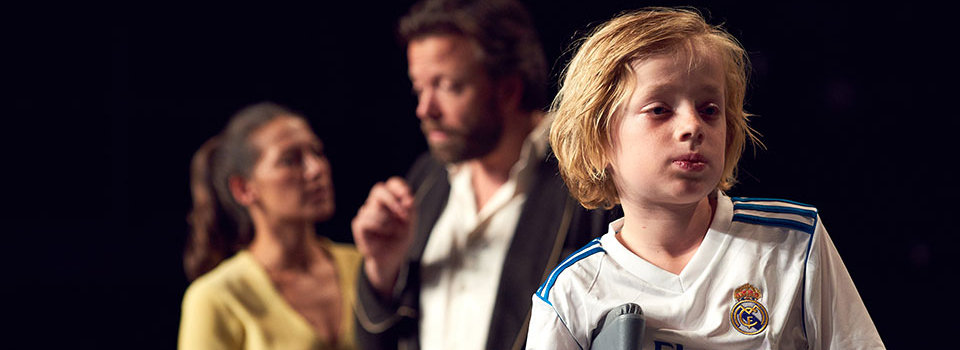
Pia Tjelta (Rita Allmers), Kåre Conradi (Alfred Allmers) & Øyvind Eide
When Ibsen returned to Norway as a world famous dramatist, and settled in Kristiana after 27 years abroad, his desire for travelling was over. To the surprise of many, he quickly settled into city life, and made the Grand Cafe his local. Even while writing his plays, he never sought peace at spas or mountain retreats high up in Alps, on the contrary; he stated that he couldn’t understand “that people with comfortable homes, were eager at the first sign of warmer weather, to leave town for the deadly boredom of the country with all its disadvantages. Not
only would one renounce all the usual conveniences and comforts of daily life such being able to work in the peace and quiet in one’s own private study, a comfortable bed, the newspapers at one’s cafe and so on in order to be shut up in a mediocre hotel far away from civilisation where one in addition to other discomforts would be at the mercy of the weather and consequently become a prisoner inside four walls without the resources of the city to fill the emptiness…”
Ibsen met the boy, Johan Hansen, a pupil at Ruseløkka School who became Ibsen’s errand boy. Little did Johan know that the playwright was busy writing Little Eyolf and was using him to study the ways of boys think and express themselves. One of those who was impressed by the play when it was published, was the fellow author Alexander Kielland. He spoke of his delight to his sister, the painter Kitty Kielland, and how surprised he was by Ibsen’s accuracy: “I find that the rat woman who takes care of the unloved little children has great depth and truth… Notice how much deeper the Old Devil gets to our true nature and shows us that the much praised love of one’s children is just the pressure of responsibility and jealousy while you have them and bad conscience when they are gone. I think the detail I most admire in the play, is after the scene with the rat woman, when Little Eyolf says to his aunt: Imagine! Now even I have seen the rat woman. That the Old Ghost can remember that this is how such an event is experienced by a boy. If you see Ibsen, you must bow all the way down to the ground three times, but you do not have to say anything. “
With regard to the idea of the rat woman, Ibsen showed his knowledge of the story of the Pied Piper of Hamelin in a newspaper interview, but that his inspiration was a woman from his childhood town Skien. We don’t know for certain, but Ibsen probably also knew of an illustrated children’s book around the Hamlin legend by Robert Browning, which appeared in German in 1889, where one of the children was depicted with crutches. The lame boy is left behind as the rat catcher with his whistle lures the other children to the promised land where they are all swallowed up by the mountain. The lame boy himself complains that he did not get there before the mountain walls closed so that he could have been cured. At the same time, he becomes a witness to the fate of the other children, those who disappeared.
In Ibsen’s play, Allmers and his disability becomes a memorial to the selfishness of adults who don’t take care of the next generation; the infant Eyolf is paralysed in one leg after falling from the baby’s changing table while his parents are busy making love. Little Eyolf, who in Ibsen’s original manuscript only wants to play with the other children and learn to swim, follows the rat woman with terrified joy, as she rows out on the fjord. She is accompanied by the dog, Mopsemand, and handles a rowing boat with an oar in one hand while playing the mouth harp with the other. Only the floating crutch testified to the fact that Eyolf had drowned. The accusing, child’s eyes staring up from the bottom of the sea becomes an image of the parents’ deceit and guilt. Rita recalls her uncompromising reaction when she felt ignored, saying that she wanted her son’s death. Alfred Allmers abandons his idea of becoming an author and the philosophical questions that provided escape from the world after his son was paralysed.
After his son’s death, and while his beloved half-sister Asta is making plans to leave them, the Allmers go through a period of transformation. The world carries on as if nothing had happened, so what else that is responsible and future-oriented could they fill the rest of their lives with? Bitterly reflecting on their own selfishness they end up opening their doors to other children. Rita will let other children fill the space left by Eyolf: “They will live in Eyolf’s rooms, read his books, play with his things and take it in turns to sit on his chair at the table.” Is this a substitute for a broken life or a new meaning of life? The play’s reception in Denmark became tainted by speculations in the press, showing an interest in the theme of the piece. The Norwegian author, Thomas P. Krag, stole and showed the pages of the drowning accident to a journalist who made his own imaginative reflections on what the content of rest of the play could be. As a consequence, the tragic scene where the crutch flows towards the shore, was received with mirth in Danish theatres. Kielland thundered: “…damn the treacherous Danes who have spoilt the important reference to the crutch. In Copenhagen, actresses struggle to be heard trough the giggles from the auditorium when making their reference to the crutch. But it serves them right – Scum of the Earth.”